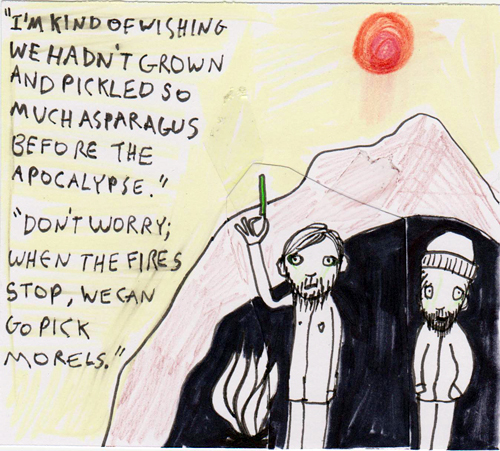
Recently, I started watching Jamie Oliver's Food Revolution on ABC. In his enthusiasm and optimism, Oliver amazes. Sometimes, for the same reasons, he also annoys. He really started making me wince in the second episode, when he was frantically goading on a sweet, morbidly obese sixth grader's cooking efforts with the fairly far-fetched promise that stir-fry expertise would endear him to the young ladies he coveted. Still, the third episode focusing on high-schoolers was more moving than it was excruciating. Some corny moments aside, his mission to improve the quality of the meals that kids and their parents wolf down is commendable and daring; to see it stretch to the United States' most nutrient-deprived corners is satisfying. While the point of their inclusion may have been a by-product of Oliver's primary intent to reform Huntington, West Virginia's diet, the footage of elementary school students tossing all greenery and non-processed items from their trays into huge gray garbage bins especially resonated with me. I'm a part-time substitute teacher for the San Francisco Unified School District, and I have seen that scene before, in very high-definition: industrial-strength receptacles stuffed to the hilt with perfectly good apples, salads, rolls, and unopened milk containers.
Sadly, the ritualized dumping only scratches the surface of what increasingly appears to be a food waste pandemic in the state of California. Each year, California farmers, restaurants and supermarkets toss six million tons of edible food. To put the amount in perspective, Oakland's Oracle Arena, or the Staples Center in Los Angeles, sports and entertainment venues with capacities approaching 20,000, could be filled to the brim, 35 times over. According to Hunger in the Golden State, a collaborative endeavor by California Watch and USC's Annenberg School for Communication and Journalism, food products represent 15.5% of our state's waste. Last week, the project reported on its findings, alleging that major "shortcomings...at every step...along California's food distribution chain [allows] vast amounts of food to go to waste in landfills despite laws and tax incentives that encourage food donations." Sharing the evidence in detail would exhaust the confines of this meager forum, but I'll let you chew on a few stirring nuggets, presented succinctly:
Last year, only 940 of the 90,000 eating and drinking establishments operating in California worked with Food Donation Connection, overwhelmingly the largest program linking food service donors with hunger relief agencies. In 2009, such wonders of sustainability as Pizza Hut and KFC accounted for over half of the participants. Why? Mom-and-pop restaurants and single-owner franchises aren't eligible for a tax deduction for food donations, and thus often elect not to get involved.
California grows half our country's fruits, vegetables and nuts, yet experts guess that farmers plow under millions of tons of produce after each harvest. While farmers don't exactly avoid efficiency, when a crop carries a price incapable of paying for its harvest, few trying to make a living off sales see the point in doubling down on a loss. Although food bank donations and gleaning operations have helped, a shockingly high percentage of most commercial crops never leave their fields. Thousands of pounds of produce are abandoned -- enough to feed whole cities. According to Hidden Harvest, a Coachella-based outfit, one local effort managed to "save" 14,000 of approximately 140,000 pounds of carrots left above ground. A 2004 study by University of Arizona anthropologist Timothy Jones claims that up to 10% of some crops, like cauliflower for example, simply rot. The overall figure for crop waste across the country, he says, may be even higher -- closer to 20%.
Many grocery stores -- like Safeway, for example -- participate in some kind of hunger relief program. At the same time, many chains only donate bakery items, or at least balk at donating perishable produce. Even though a 1996 federal statute protects donations made in good faith against liabilities, stores reportedly worry they'd be held responsible if anyone fell ill after eating donated meat or vegetables. "Many grocery stores decline to give food because they're either unaware of the liability protection in place or they feign ignorance of the law because they don't want to bother," Jonathon Bloom, author of the blog Wasted Food, was quoted as saying. "Almost as often, stores know they'd win such a lawsuit, but are afraid of the negative publicity they'd face if such a suit happened."